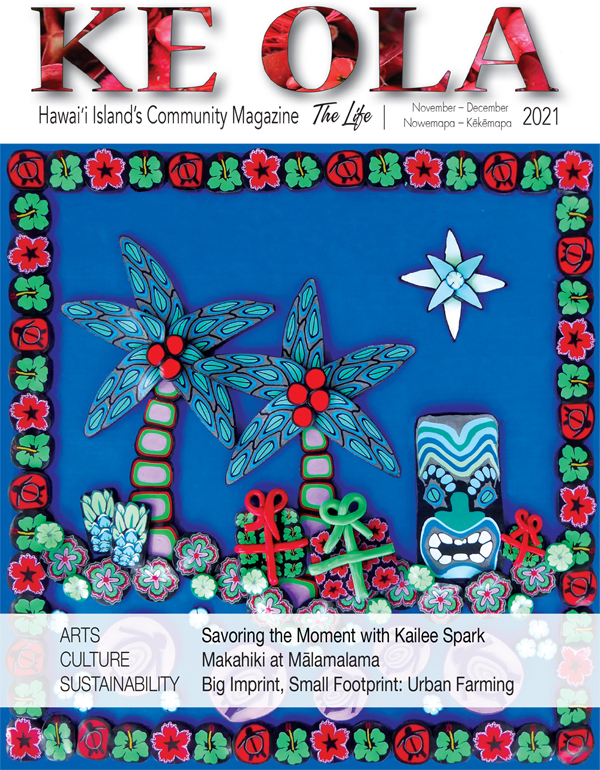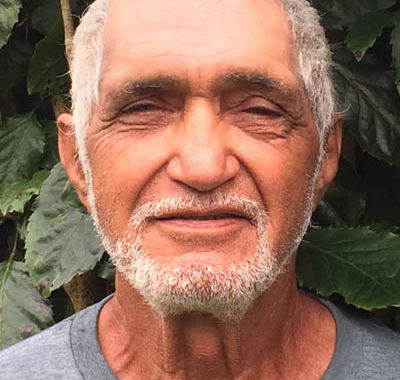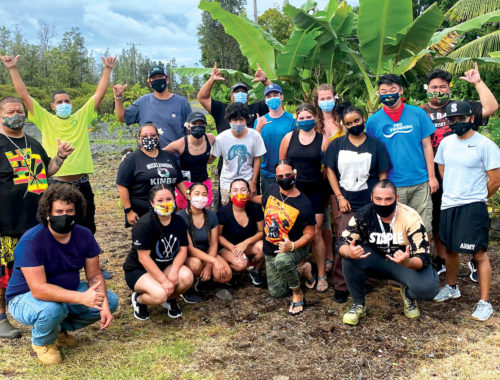
Makahiki at Mālamalama

By Stefan Verbano
Students at Mālamalama Waldorf School in Kea‘au will ring in the Makahiki season a little differently this year.
Gone will be the crowds of spectators, the buffet tables groaning under the weight of steaming pots of taro and breadfruit, and the raucous spectacle of the school’s annual game of hukihuki—Hawaiian tug-of-war—which have all become fixtures of the ancient harvest celebration akin to Thanksgiving held every November at Mālamalama’s 26-acre campus in Hawaiian Paradise Park.
Like tug-of-war, many of the other games closely associated with Makahiki have been cut from the school’s program, too: wrestling matches, foot races, spear sliding competitions, and ulu maika—a game resembling American bowling where players try to roll disc-shaped stones between stakes set in the ground. Planners had to make dramatic changes to the typical festivities this year due to coronavirus restrictions, choosing to go a similar route as 2020’s scaled-down version.
With so many of the usual “Makahiki Games” out, Mālamalama’s celebration now focuses on the one event that will remain largely unchanged this year: a part of the school’s Makahiki tradition that honors a living cultural heritage connecting modern Hawai‘i back through the ages to its ancient past. It is this ancestral connection that the school’s Hawaiian studies teacher Mahina Peleiholani Blankenfeld-Kaheiki hopes her students will experience firsthand during what she calls “the ceremony.”
It starts with a three-tiered raised platform built by the 8th grade class from natural materials they harvested themselves from school grounds in the weeks leading up to the big day. Fashioned from bamboo poles and strawberry guava branches, lashed together with rope, this is known in Hawaiian as the Nu‘u Tower, its three levels representing the akua (gods), the ali‘i (chiefs) and the maka‘āinana (common people).
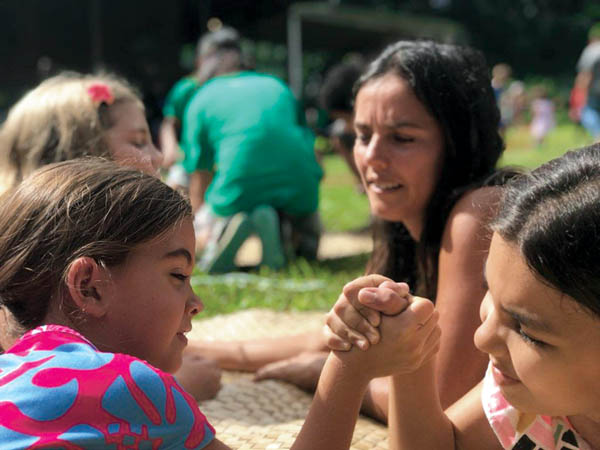
The classes gather outside on the school’s expansive lawn. The students’ hands are full. While their peers stand close by reciting over and over the oli lei, a traditional Hawaiian chant used while making offerings, each classmate takes their turn at approaching the tower and laying on its bamboo shelves whatever gifts they have brought for Lono, the ancient Hawaiian fertility god around which all of Makahiki revolves. Chanting only stops when the final student has added their contribution to the shelves, which by then are overflowing with lei, ornamental ginger, hibiscus flowers, breadfruit leaves, papayas, pineapples, ti leaves, and citrus fruit. The Nu‘u Tower is left standing for the whole four-month season, and then finally disassembled and buried along with all of its weathered offerings in a sacred spot on the school’s grounds.
The meaning behind this simple act of placing offerings on the tower drives the entire celebration, Mahina says, and is deeply rooted in the Hawaiian tradition of ho‘okupu. This is why, even after so many other beloved events were cut from this year’s roster, the ceremony simply had to proceed.
“Itʻs about gratitude,” she says. “Ho‘okupu is our main word for ‘offering.’ For us as a people, Makahiki is the time when we give our best. Traditionally, that meant whatever you specialized in: a weaver would give their best mat, made from the best materials they had. A fisherman would give their best fish; a farmer would give their best crops. They’d do it to give reverence and to honor Lono for giving us such a rich harvest for the season, for helping us with our productivity and making our land rich and fertile.”

The Akua Loa
The other main component of the ceremony that festival planners like Mahina deemed crucial for the students to experience this year is the procession of the akua loa. This is when pupils in the eldest class parade around the school carrying a long pole draped in white cloth known as the “image of Lono” which, like the Nu‘u Tower, they build themselves out of local materials prior to the ceremony. In the age of ancient Hawai‘i Island, priests would carry the akua loa in a clockwise rotation around the island, ushering in the Makahiki season and collecting ho‘okupu in each community they visited.
This effigy of Lono even has a peculiar connection to the history of European contact with ancient Hawaiians. Captain James Cook happened to arrive at Kealakekua Bay on Hawai‘i Island’s Kona Coast near a large heiau (temple) to Lono during the Makahiki season of 1778, and went on to make the first recorded European contact with the Hawaiian people. Some stories say the sails and masts of Cook’s ship resembled Lono’s akua loa enough that, along with these other coincidences, many were convinced that Cook was an incarnation of Lono.
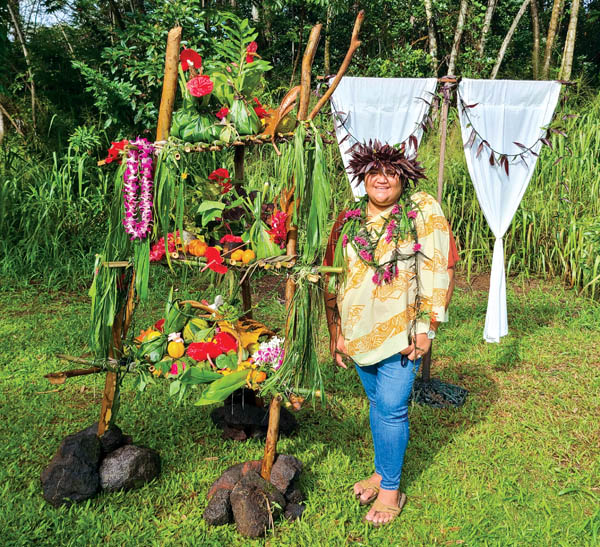
Traditionally, the akua loa would be made of wood from native trees like ‘ōhi‘a and adorned with white kapa cloth made from the beaten inner bark of select trees and shrubs. Known as “tapa” elsewhere in Polynesia, this material has been an essential element of Hawaiian textiles throughout its history. But real kapa—and ‘ōhi‘a poles for that matter—isn’t easy to come by these days, so the school improvises with what it has on hand.
“What we have isn’t made of traditional materials since it requires resources not available to us, so we use modern resources to represent both,” Mahina says.
Many aspects of Mālamalama’s Makahiki celebration seem to take place at this crossroads of ancient and modern. The Hawaiian studies kumu (teacher) admits that harvesting strawberry guava branches to construct the Nu‘u Tower is a deviation from tradition, which, like the akua loa, would have called for using branches from native trees rather than the emigrant guava, which some Hawai‘i conservationists consider to be the “most invasive plant” in the state. But, the wise teacher explains, opting to use the guava wood presents an important opportunity for the students to learn a lesson about ecology in Hawai‘i today.
“I try to teach my students about the importance of managing our resources and the difference in what our forests were pre-contact to what they look like today,” she says. “We know the introduction of invasive species has heavily impacted our native forests, so in order to teach them about preservation, we agreed to use readily available invasive species to help manage their population and to actually utilize them.”

Makahiki of Old
This year, Makahiki festivities will last only one day at the school, and even during normal seasons the school’s events would typically only be one week long. Compare this with the four consecutive months ancient Hawaiians would spend celebrating: from late-October/early-November (as determined by the moon’s cycles), through February or March, making the revelry more a phase of the year rather than a solitary occasion. During Makahiki, work was prohibited and there were days upon days of feasting, hula performances, dancing, chanting, visiting of relatives, and sporting competitions where wagers would be placed on local champions. All warfare was forbidden. The other eight months of the year were spent under the auspices and rituals of the god Kū, one of the four principal gods in Hawaiian mythology—the other three being Lono, Kāne, and Kanaloa.
The Pleiades star cluster appearing in the night sky marks the transition from the season of Kū to the season of Makahiki. In Hawaiian, the Pleiades are known as Makali‘i, and it’s from the term Makali‘i hiki, or “rising of the Pleiades,” that the season derives its name. By pure coincidence, it occurs in mid to late November near the similarly harvest-oriented US holiday of Thanksgiving, prompting some to call Makahiki the “Hawaiian Thanksgiving,” although history contends that the celebration of Makahiki predates the advent of Thanksgiving by many centuries.
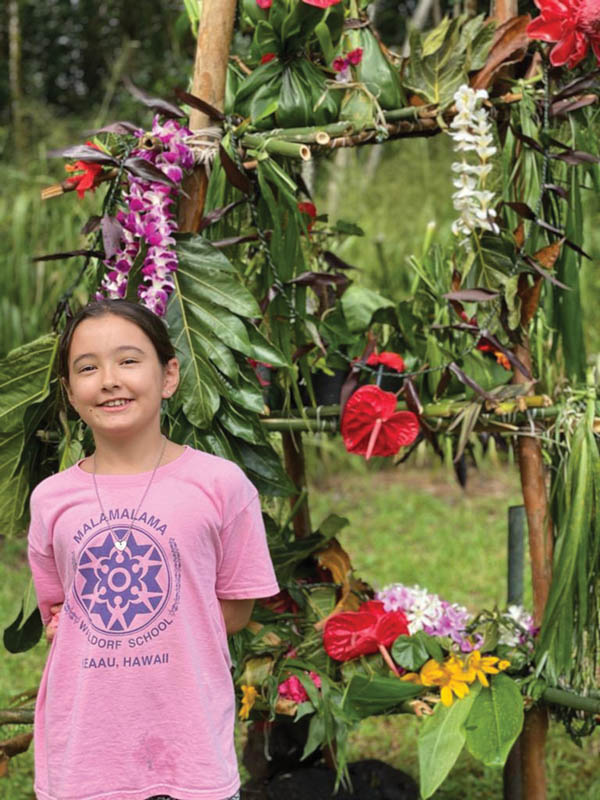
For a school like Mālamalama Waldorf that specializes in place-based education, teaching its students all these hidden meanings through the celebration of a holiday like Makahiki is crucial to their understanding and appreciation of the cultural context of where they live.
“It’s to pay homage to a place, to a time in our history,” Mahina says. “Makahiki is about peace, prosperity, celebrating the harvest, celebrating our relationships, and celebrating everything we are doing in school, in our homes, in our community.”
When asked about how the traditional Hawaiian ethos of mālama ‘āina (caring for the land) plays into Mālamalamaʻs conception of Makahiki, Mahina says the school’s name pretty much sums it up.
“Mālamalama means ‘shining with knowledge,’” she says. “If you are shining with knowledge and you are a child of this land and you go to this school, then it’s your job to mālama this ‘āina,” she says. “Mālama ‘āina isn’t only about taking care of something physical like the land itself, but the ‘āina can be something that feeds you spiritually or feeds you mentally: taking care of your parents because they raised you, taking care of your spiritual needs, taking care of everything that helps you develop as a person.” ❖
For more information: hawaiiwaldorf.org
